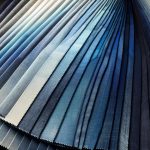Denim, often described as a classic wardrobe staple, carries with it a certain mystique when it comes to its color. The question of what color denim truly is might seem straightforward at first glance, but a deeper look reveals a complexity that is as intriguing as it is surprising.
From the origins of denim dyeing to the influence of modern trends, the spectrum of denim hues is as diverse as the individuals who wear this versatile fabric. So, what exactly makes denim's color so intriguing? Let's explore together.
Table of Contents
Key Takeaways
- Denim color ranges from deep blues to light washes, offering a spectrum of hues.
- Indigo dye, with its rich tradition, gives denim its iconic blue color.
- Various dyeing techniques influence denim shades, reflecting different styles and moods.
- Denim color trends evolve, incorporating vintage washes and bold hues to appeal to diverse preferences.
History of Denim Dyeing
Denim dyeing has a rich and fascinating history that dates back centuries, with origins rooted in ancient textile traditions. The iconic blue hue of denim can be traced back to the use of natural indigo dye, derived from plants such as the indigofera tinctoria. This dyeing technique has been practiced for generations, with artisans perfecting the art of creating beautifully dyed fabrics.
Indigo, with its deep and enduring color, has been the preferred choice for denim dyeing due to its ability to create vibrant and long-lasting shades of blue. The process of dyeing denim involves immersing the fabric in vats of indigo dye multiple times to achieve the desired color intensity. Each dip allows the dye to penetrate the fibers, resulting in the classic denim shade loved worldwide.
Over the years, various dyeing techniques have been developed to enhance the uniqueness of denim, from traditional methods like rope dyeing to modern innovations such as laser or ozone treatments. These techniques not only contribute to the aesthetic appeal of denim but also play an essential role in creating different washes and finishes that define the diverse range of denim styles available today.
Various Shades of Denim
Indigo dyeing techniques have led to a spectrum of shades in denim, ranging from deep blues to light washes, offering a diverse array of options for denim enthusiasts. Dark wash denim, characterized by its rich, deep blue hue, exudes a classic and sophisticated vibe. It's perfect for a polished, timeless look that can easily shift from day to night.
On the other end of the spectrum, light wash denim has a more casual and laid-back feel. The pale blue tones give off a relaxed and vintage aesthetic, making it a popular choice for a more effortless and carefree style. Light wash denim is great for creating a cool and effortless vibe, ideal for weekends or casual outings.
Whether you prefer the sleek elegance of dark wash denim or the relaxed charm of light wash denim, the wide range of shades available offers a perfect denim hue for every occasion and personal style preference.
Indigo: The Iconic Denim Color
Exploring the history of dyeing techniques reveals the significance of indigo as an iconic color in the world of fashion and textiles. Indigo dye, derived from the plant Indigofera, has a rich tradition dating back centuries. Here are three fascinating aspects that make indigo a standout color in the domain of denim:
- Historical Significance: Indigo dye holds a special place in many cultures due to its historical importance in textile production. Its use can be traced back to ancient civilizations, showcasing its enduring popularity over time.
- Unique Aging Process: One of the distinctive features of indigo-dyed fabric is its ability to develop a beautiful patina over time. This characteristic sets it apart from other dyes, as indigo garments tend to age gracefully, adding to their allure.
- Symbol of Authenticity: Indigo is often associated with authenticity and craftsmanship in the world of denim. Its deep, rich hue evokes a sense of tradition and quality, making it a favored choice for denim enthusiasts seeking timeless pieces.
Factors Influencing Denim Color
Understanding the various dyeing methods and materials involved in the production of denim can greatly impact the final color outcome of the fabric. The fabric composition, dyeing process, environmental impact, and color psychology all play important roles in determining the color of denim.
| Factors | Description |
|---|---|
| Fabric Composition | The type of fibers used in denim, such as cotton, polyester, or a blend, affects how the fabric absorbs dye. |
| Dyeing Process | The method of dye application, whether it's rope dyeing, slasher dyeing, or other techniques, influences the depth and shade of the final color. |
| Environmental Impact | The chemicals and water usage in the dyeing process can have environmental implications, making sustainable dyeing practices essential for eco-friendly denim production. |
| Color Psychology | Denim color choices can evoke different emotions and perceptions in consumers, impacting their purchasing decisions and overall fashion trends.
Considering these factors when exploring denim colors can deepen one's appreciation for this versatile fabric.
Denim Color Trends
Have you noticed the shift in denim color trends this season? Denim color palettes are evolving, reflecting a mix of classic shades and bold new hues. Let's investigate the denim color psychology to understand the impact of these trends:
- Vintage Washes: Classic blue denim with faded accents is making a comeback, adding a touch of nostalgia to modern looks. These vintage washes give off a relaxed and timeless vibe, perfect for casual ensembles.
- Earth Tones: Denim in earthy hues like olive green, terracotta, and mustard is gaining popularity, bringing a natural and organic feel to outfits. These colors evoke a sense of grounding and connection to the environment.
- Bleached Denim: Light wash and bleached denim are becoming go-to choices for a fresh and summery appeal. The light colors convey a sense of brightness and optimism, perfect for adding a youthful touch to your wardrobe.
As we explore these denim color trends, it's fascinating to see how color can play a significant role in shaping our style and mood.
Frequently Asked Questions
Can Denim Be Dyed in Colors Other Than Indigo?
Absolutely, denim can be custom dyed in a variety of colors beyond indigo. This process allows for unique patterns and vibrant hues, giving denim a fresh and personalized look that stands out in fashion.
How Does the Washing Process Affect the Color of Denim?
When denim undergoes the fading process during washing, the color retention can vary. Bleaching effects can lighten the fabric, while the darkening process might occur due to certain dyes or wash techniques.
Are There Any Environmentally-Friendly Methods for Dyeing Denim?
Exploring eco-friendly alternatives and sustainable practices in dyeing denim is essential. Implementing innovative techniques like natural dyes, waterless processes, and upcycling can reduce environmental impact while maintaining style and quality.
What Are Some Common Misconceptions About Denim Colors?
Common misconceptions about denim colors often stem from color perception and fashion trends. Some believe denim is only blue, but dye techniques and fabric composition offer a range of hues beyond traditional blue shades.
How Do Different Fabrics and Materials Affect the Color of Denim?
Different fabrics and materials can impact denim color through fabric composition and dyeing techniques. Color perception is influenced by material blending. Understanding these elements is important for mastering the nuances of denim coloring.
- Exploring the Beauty of Printed Silk Crepe De Chine Fabric - June 20, 2025
- A Closer Look at Sanderson’s China Blue Fabric Collection - June 20, 2025
- Understanding the Link Between Louis Vuitton and Fabric Manufacturing in China - June 20, 2025







